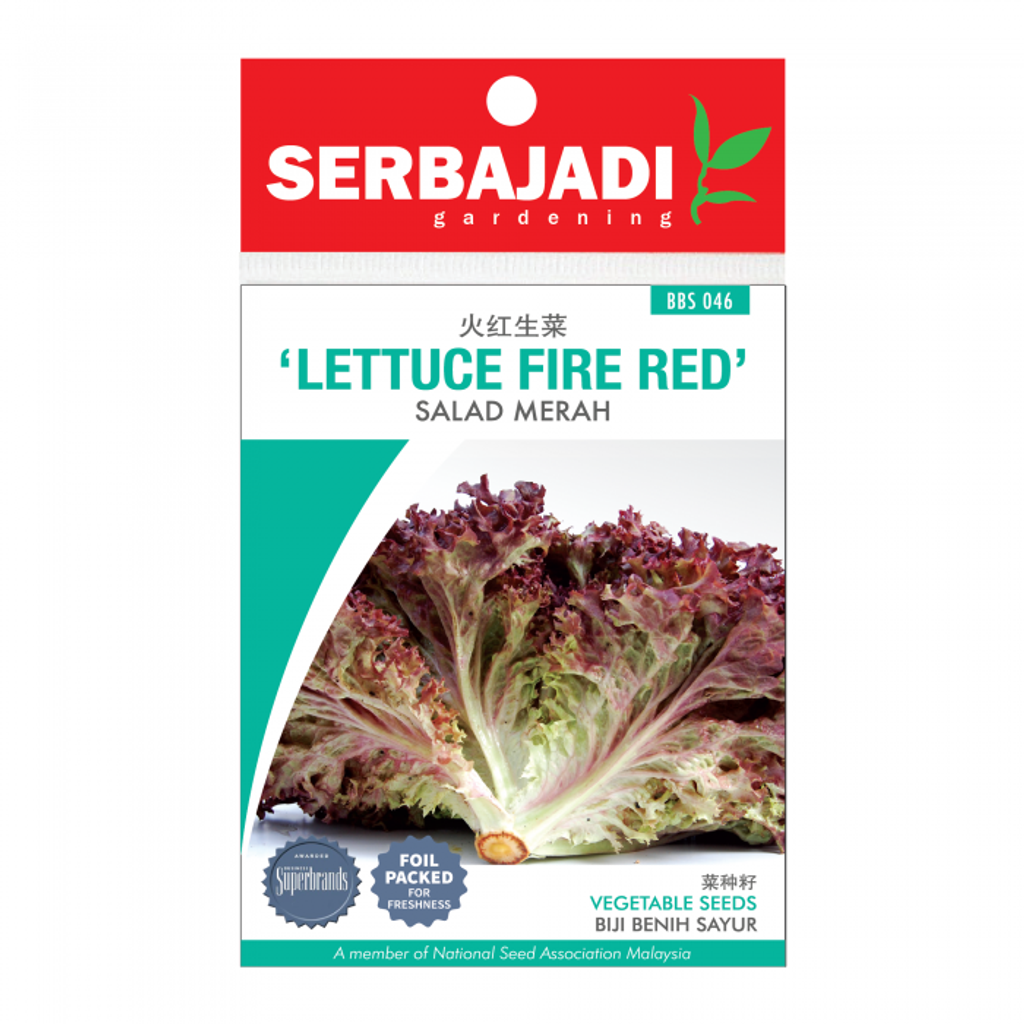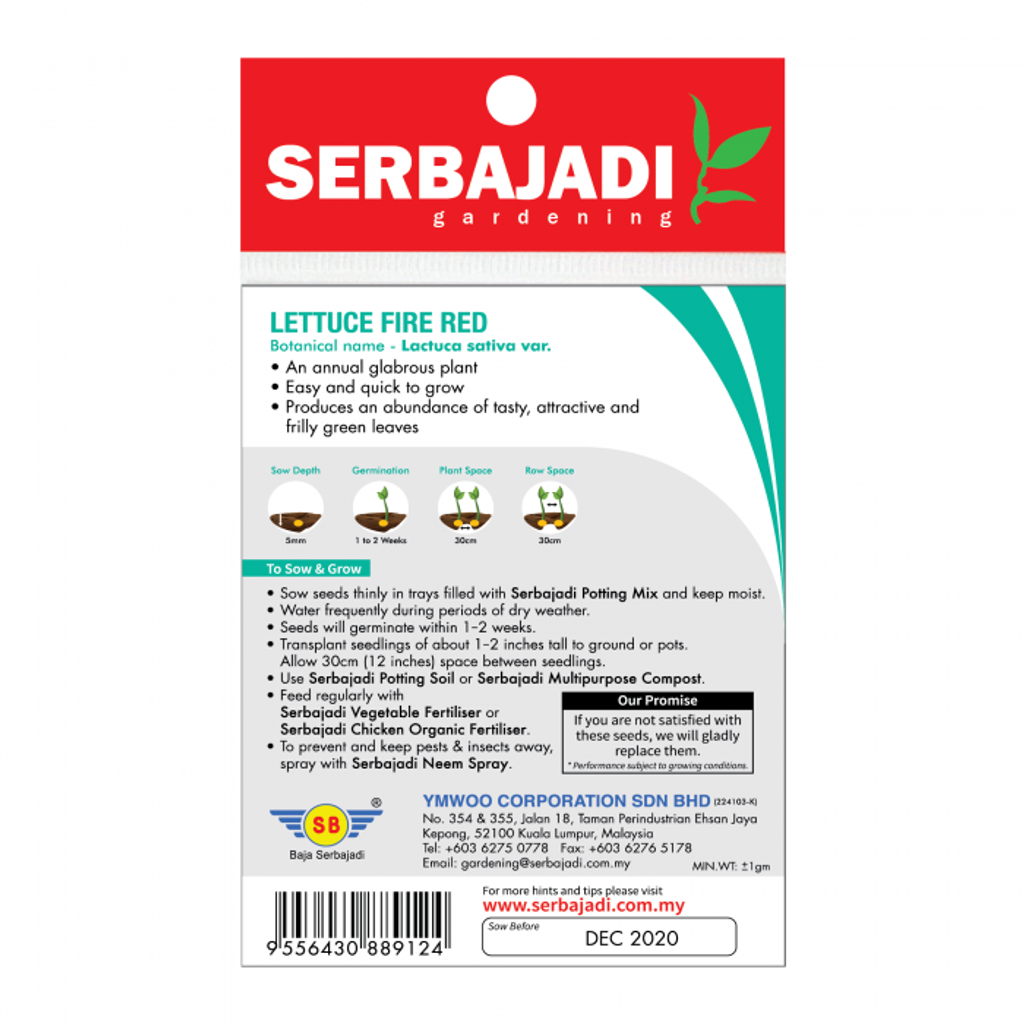Serbajadi Seeds Lettuce Fire Red ( BBS046 ) (+/- 250 Seeds)
Serbajadi Lettuce Fire Red - Lactuca sativa var.
Lettuce Fire Red is an annual glabrous herb with cylindrical stems and attractive deep red leaves. They are incredibly ornamental as well as appetizing. This is a vigorous grower producing an abundance of tasty, attractive, frilly green leaves. Lettuce is the starting point for every good salad. It is also a basic in sandwiches, and as a decorative garnish for other foods. It is nutritious, yet low in calories. That is why it is so popular for dieters, and for those who want to stay trim. Dieting and health issues aside, we eat lettuce because it tastes good! This vegetable is also generally cooked as a vegetable and added to soups and stir-fries. It is a source of beta-carotene and vitamin A.
Type of vegetable: Leafy
Edible parts: Leaves, stems and shoots
DIRECTION OF USE
Best soil: Lettuce requires a rich but well-drained soil with plenty of compost dug in and continual watering during the growing season if they are to thrive. The seedlings of lettuce do not grow well in acidic soil. A soil ph of 6 and 7 is most suitable and preferred.
How to plant: Lettuce seeds are very fine. Before sowing, the seeds are usually placed in a thin cotton cloth bag and soaked in water for an hour. The seeds can be mixed with fine sand and sown directly. You can also plant indoors in pots. Given a lot of direct sunlight, it also results in a strong seedling. When transplanting in the garden, you can give it the proper spacing. Liming is necessary before seed sowing. Cover the seeds with a very fine layer of loose soil or starting mixture. Whether sowing indoors or out, you will likely want to transplant your seedlings with the proper spacing for full development without crowding. Lettuce likes lots of moisture. Transplanting should only be done in cool, preferably cloudy weather. If the weather is hot and sunny, we recommend putting off transplanting if possible. If this is not possible, then transplant in the evening. Water thoroughly and every day after, unless it rains, for about a week. The key to growing crisp, sweet lettuce, is to get it growing at a fast pace. That means plenty of water, and a healthy dose of fertilizer. When transplanting lettuce in hot weather, place some form of sun shade over the plant for a couple of days. Any makeshift shade will do.
When to harvest: 30 to 45 days after sowing of seeds, can be ready to begin cutting in as little as three weeks when leaves are 6” to 8” tall. Harvesting should be done in the early part of the day. Pick lettuces as soon as it is big enough to use. The outer leaves can be picked and the inner leaves are allowed to grow further. Or, use the plants pulled while thinning. Loose leaf varieties will grow back after cutting.
How to harvest: For greens, use whole plants when they are small. Use a sharp knife or scissors to cut off 2” to 3” from base of the stem. Or the whole plants are pulled up.
Care: Water frequently during dry spells. Slugs and snails, as well as caterpillars are the biggest problem. Insects can become a real problem, too. Lettuce is delicate, and can absorb many insecticides. If you want or need to use insecticides, look for brands that are less harmful to you and the environment. We like to avoid insecticides on leafy vegetables wherever possible. We suggest organic sprays and a willingness to give up some of the harvest to insects versus using pesticides. After all, one of the reasons most of us have gardens is to avoid the pesticides. We do not recommend insecticides at all for loose leaf lettuce varieties. Slugs are a real problem for all types of lettuces. There are a variety of control methods.
STORAGE
Keep away from children and pets.
Store in cool and dry place away from direct sunlight.


